
Dear Clients:
We’re glad to put Q3-2023 in the rearview mirror, as the third quarter lived up to its historical billing as the weakest quarter of the year. As we’ll discuss, interest rates surged, which proved to be a headwind too strong for stocks to overcome. Nobody knows what lies ahead. On the positive side, while past performance is no guarantee of future results, according to Sam Stovall, Chief Investment Strategist of CFRA, the S&P 500 Index gained an average of 5.0% during the fourth quarter of all years since 1990, rising in price 82% of the time. More impressive, during Q4 of pre-election years (i.e., the quarter we’re now in), the S&P 500 gained an average of 7.7% and rose in price 88% of the time.
On the negative side of the ledger, while we avoided the chaos of a government shutdown when Congress passed and President Biden signed a “Hail Mary” stopgap budget bill just hours before the midnight deadline on September 30, we got a new, potentially more disruptive chaos three short days later when the U.S. House elected to remove Rep. Kevin McCarthy as Speaker. With the stopgap bill keeping the government funded only through November 17 and the U.S. House effectively closed for business until a new Speaker is elected, investors have jumped from one frying pan into another.
It’s uncomfortable being in the frying pan and nobody knows for sure how this will all play out, certainly not us. That said, we will not be surprised if the tenor of the stock market continues to be negative and volatile as we near the precipice of a shutdown (again). In rocky times like these it’s crucial to remember we own companies with real, profitable businesses, not a bunch of stock ticker symbols. While a company’s stock price can change rapidly from day-to-day, the value of the underlying business is much more stable.
We think you’ll experience a lot less stress and anxiety if you turn off the TV and instead keep these thoughts in mind:
Stay calm. Since 1980 there have been twelve bear markets (declines of 20% or more). They are a scary, but normal part of your investment journey.
Stay in. If you invested $100 in the S&P 500 on January 1, 1973 and left it alone, you would have had $3,252.44 on December 31, 2022 (and 2022 was a terrible year). However, if you had missed only the single best day in each of those 50 years because you got scared, you would have had only $540.23.
Stay the course. The longer your investment time horizon, the less volatility you will experience and the higher your odds for a positive outcome. From January 1950 through December 2022, rolling one-year returns were positive 79% of the time (range -43.3% to 61.2%). Rolling ten-year returns were positive 97% of the time (range shrank to -3.4% to 19.5%).
Strength in Mega-Capitalization Technology Stocks Masks Average Stock is Flat
This continues to be the year of a small handful of mega-capitalization technology stocks. Since the S&P 500 Index is capitalization-weighted, the performance of the 10-largest capitalization stocks (2% of the stocks in the index (10/500), but with a 32% index weighting) can have a disproportionate impact on index performance. In fact, through the first three quarters of 2023, Bespoke Investment Group calculated the 10-largest capitalization stocks accounted for a whopping 88% of S&P 500 performance. Because of this, we think the equal-weighted S&P 500 Index (each stock with same 0.2% index weighting) paints a more accurate picture of the performance of the average stock. Additionally, “Growth” stocks continued to outperform “Value” stocks by a wide margin.
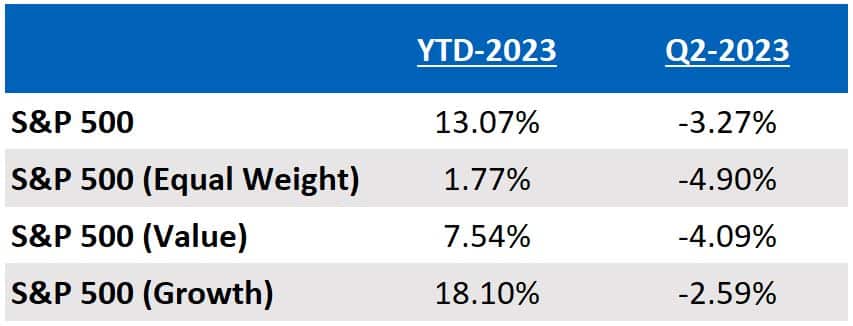
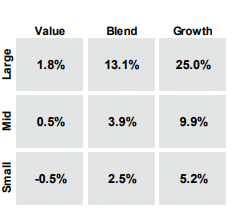
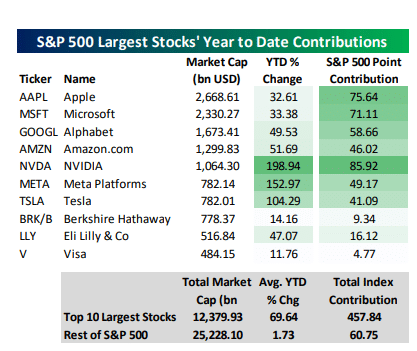
Maybe Fitch Downgrade of U.S. Credit Rating Was a Big Deal, After All?
A credit rating is used to predict the likelihood a borrower will repay its debts, on time and in full. Whether you’re an individual, company or a sovereign nation, a strong credit rating is treasure that must be guarded zealously. Your creditworthiness determines both your access to credit and the cost. The “riskier” you are considered as a borrower, the higher the interest rate a lender will demand to compensate for assuming your risk.
Indeed, if you have “sterling” credit and are a “prime” borrower, the financing world is your oyster. Unfortunately, if you’re less than “sterling” or “sub-prime,” credit is both harder to come by and more expensive. What’s true for consumers is also true for companies and governments. From a lender’s point of view, the very best outcome is the borrower makes all of its scheduled payments, in full and on time. In other words, while there is no upside from “in full and on time,” there is a whole lot of downside. So, the riskier the borrower, the more expensive it is to borrow.
We’ve included a reprint of our August 18, 2023 column for the Indianapolis Business Journal, “Fitch downgrade a warning U.S. approaching a financial reckoning.” The headline referred to Fitch Ratings’ decision on August 1 to strip the United States of its “AAA” credit rating (dropping it to AA+), but the “why” and potential implications are more important than the rating itself. As the pecking order of credit rating agencies go, Fitch is a distant third to S&P and Moody’s, so Fitch’s decision was widely mocked (as was S&P way back in 2011 when it dropped the United States to AA+, where it remains to this day).
In announcing its decision, Fitch said the reason for the downgrade “reflects the expected fiscal deterioration over the next three years, a high and growing government debt burden and the erosion of governance relative to ‘AA’ and ‘AAA’ rated peers over the last two decades that has manifested in repeated debt limit standoffs and last-minute resolutions.”
Regardless of credit rating, buyers of U.S. government bonds will decide for themselves. The risk is if enough of them come to believe S&P and Fitch are correct “the emperor has no (AAA) clothes” and thus doesn’t deserve to borrow at the lowest interest rate, they will demand a higher rate to finance our government’s ever-increasing level of debt. In other words, if the lawmakers have no political will for fiscal discipline, the “bond vigilantes” will impose it on them.
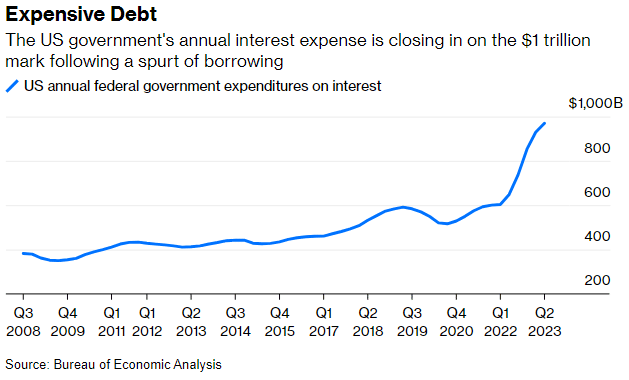
The implications are critical. The U.S. Treasury not only has to issue new debt at much higher interest rates to replace maturing debt (more than half of America’s outstanding debt matures within the next three years), it has to issue more of it to fund the ever-increasing budget deficit. Our national debt stands at $32 trillion, 20% more than our annual Gross Domestic Product. Interest costs now consume 14% of tax revenues, up sharply from 2-4% during the Fed’s recently concluded 12-year “zero interest rate” policy period. Indeed, the yield on the 10-year U.S. Treasury bond jumped from just below 4% prior to Fitch’s action to 4.6% by the end of September, a huge move in a short period of time. Similarly, the S&P 500 declined 6.6% over the same period.
On September 25, Moody’s (the last of the three major credit rating agencies giving the U.S. its top rating) warned a government shutdown “would underscore the weakness of U.S. institutional and governance strength relative to other Aaa-rated sovereigns.” Further, “a government shutdown would demonstrate the significant constraints that intensifying political polarization continue to put on U.S. fiscal policymaking during a period of declining fiscal strength, driven by persistent fiscal deficits and deteriorating debt affordability.” Sound familiar?
Moody’s’ confidence is clearly wavering as we head towards another potential shutdown, so fasten your seatbelts.
What Should We Do Differently in Response to a Likely Government Shutdown on November 18?
In a word, nothing.
It’s important to understand the hotly contentious debate about keeping the government fully funded and operational is related to, but separate from, the hotly contentious debate over whether to raise the debt ceiling that took place earlier this year. In the debt ceiling debate, the biggest risk was the U.S. defaulting on its debts if lawmakers did not raise the debt ceiling. Defaulting occurs when the U.S. Treasury has insufficient resources to satisfy the government’s existing obligations. Fortunately, the U.S. has never defaulted, but if it ever did it would have significant negative implications for U.S. creditworthiness, not to mention a devastating effect on the global economy and financial system.
By contrast, a shutdown occurs when the federal government suspends services deemed “non-essential” (like national parks and museums) because a new law to fund discretionary spending programs was not approved ahead of a fiscal year deadline (October 1). “Essential” services (like the U.S. Armed Forces, U.S. Mail, FAA, TSA, U.S. Customs and Border Patrol) continue, but personnel receive no pay. When agreement on a new funding bill is not reached, Congress may pass a “continuing resolution” extending previous funding levels to keep the government fully operating.
According to Vanguard, shutdowns have occurred more than 20 times since 1976. Although there can be heightened market volatility leading up to and during a shutdown, history reveals no clear relationship between shutdowns and stock market returns. Markets have historically had mixed reactions to government shutdowns, with equities finishing in positive territory more than half the time (as noted in the accompanying chart). In the seven instances where shutdowns have lasted 10 days or more, the Standard & Poor’s 500 Index fell four times within the shutdown period and rose three times. The worst return, –4.4%, came during an 11-day shutdown in 1979.
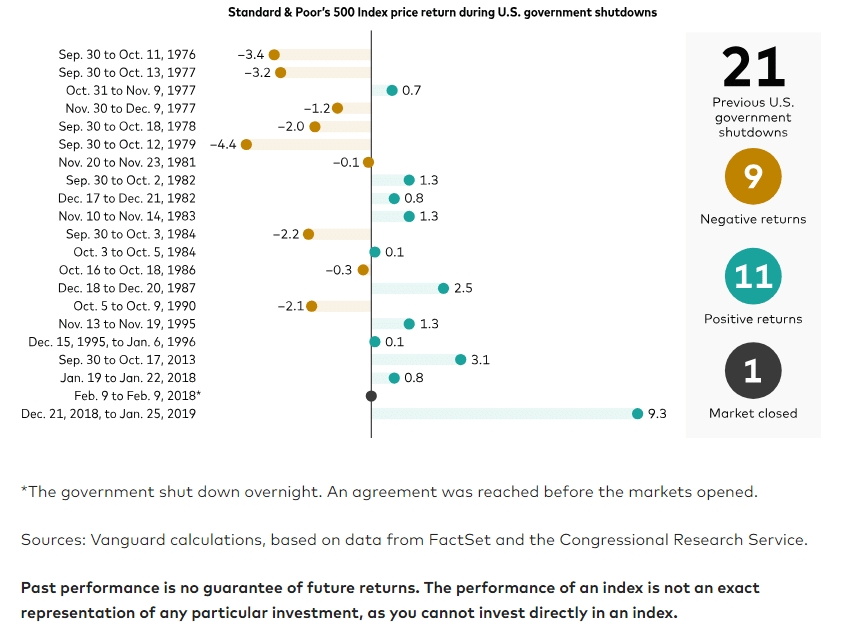
A government shutdown is only one of many factors, both positive and negative, that affect markets. Because there are so many variables, the effects cannot be accurately predicted. Unfortunately, it seems likely deep and highly partisan political divisions are going to be an unfortunate and unpleasant fact of life going forward. As always, what is most important is you remain disciplined and patient during events and periods like these.
Summary
We understand sharp drops are hard to stomach, but also realize they are a natural and necessary part of our collective investment journey. It’s human nature to want to “do something” to avoid the short-term pain, but study after study show that’s usually harmful to long-term success.
Three illustrations from Vanguard below demonstrate these points.
1. Downturns aren’t rare and investors will likely endure many during their lifetime.
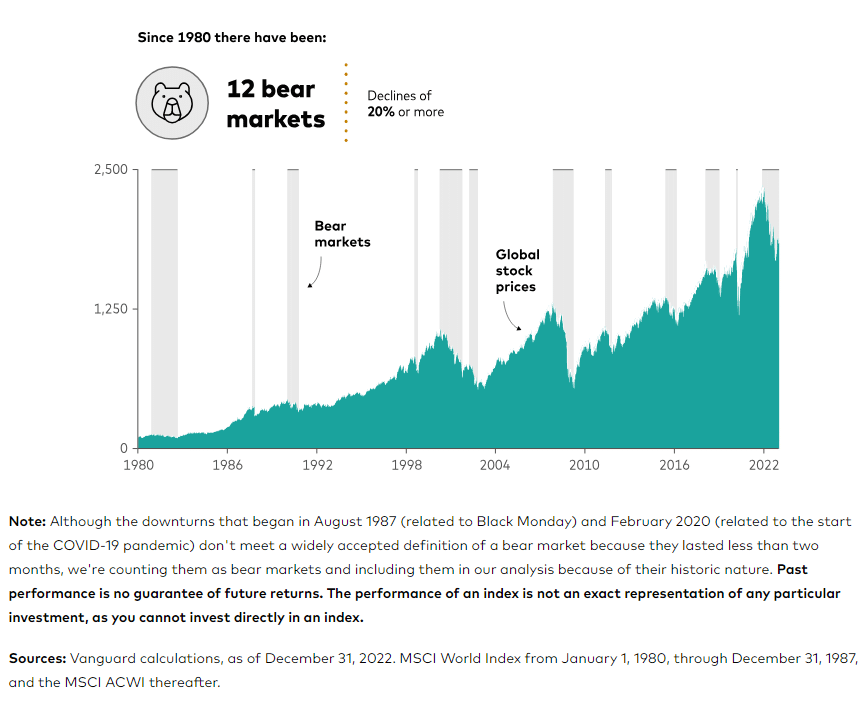
2. Some bear markets since 1980 have been sharp, but many bull markets surges have been both more dramatic and lasted longer, leaving investors well compensated over the long term for the risk they took on.
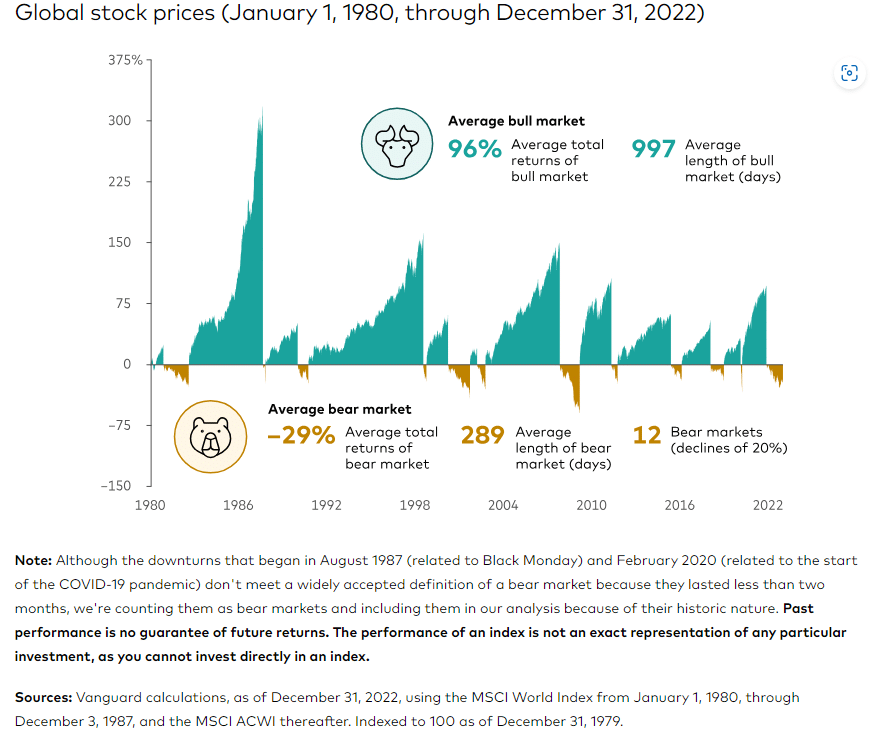
3. Timing the market is futile; the best and worst trading days often happen close together.
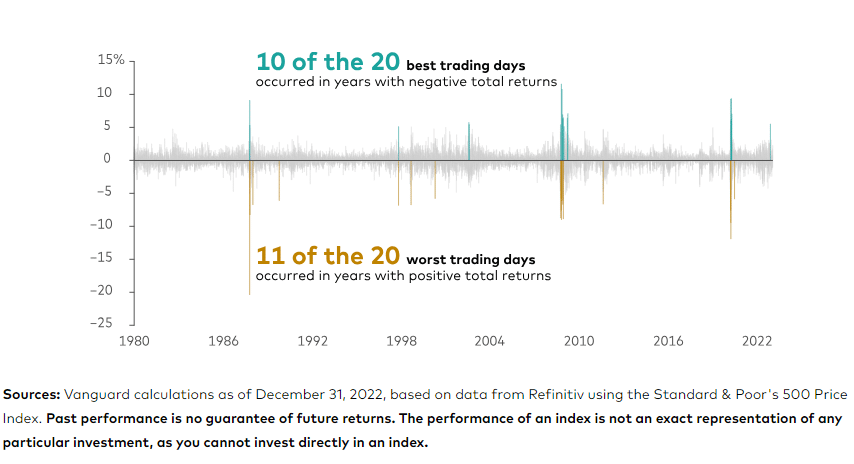
KM Privacy Policy Notice
Under Securities and Exchange Commission Regulation S-P, KM is required to deliver its Privacy Policy Notice to each client prior to the establishment of an account and updates annually. We are delivering our 2023 annual update to each client account with this letter. In addition, given the increasing importance of protecting clients’ personal information, we have implemented a policy whereby KM personnel will not release any information about a client’s account without specific authorization from the client. If you would like KM to release information about your account to your CPA or other service provider, please contact Director of Client Service Matt Kirr ([email protected]), Associate Director of Client Service Zach Greiner, CFP ([email protected]) or Associate Director of Client Service Maggie Kamman, CMA, CFP ([email protected]) by e-mail or at 812-376-9444 or 800-808-9444.
Regards,
Kirr, Marbach & Company, LLC
Past performance is not a guarantee of future results.
The S&P 500 Index is an unmanaged, capitalization-weighted index generally representative of the U.S. market for large capitalization stocks. This index cannot be invested in directly.
The S&P 500 Value and Growth Indices are sub-indices of the S&P 500 Index whose constituents are determined based on the ratios of book value, earnings and sales to price. These indices cannot be invested in directly.









